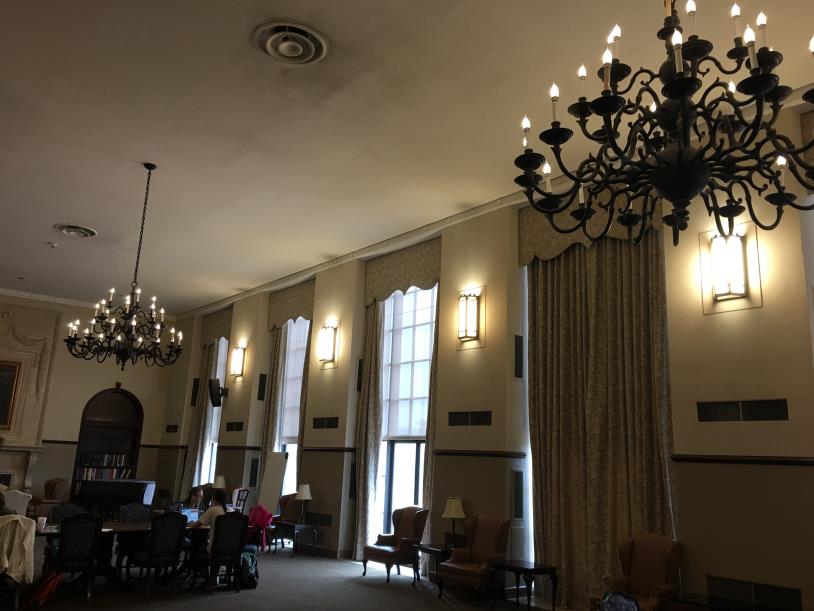Considering the Illumination of a University Library Browsing Room: A Case Study of Existing Conditions and Retrofit Recommendations
Main Article Content
Abstract
Interior lighting in university libraries should provide appropriate lighting levels and styles for diverse library users to perform associated visual tasks. Beyond reading and writing, new modes of research and socialization need to be considered for the lighting design of university libraries. The purpose of this study was to examine the illumination of a university library browsing room. The specific aim of this study was to assess the existing conditions by comparing to industry light level standards for retrofits recommendations. Observational Field study was conducted, and field measurement of illumination was taken. The current light levels were compared to the industry light level recommendations by the Illuminating Engineering Society. The findings showed that the current light levels didn’t comply with industry lighting recommendations. Lighting retrofit with light-emitting diode (LED) lighting fixture to provide higher lumens per watt was recommended for the university library browsing room. The proposed LED wall sconce with a scroll design and a custom finish is anticipated to be perceived as compatible with the browsing room’s historic interior design. This field study adds value by providing ways to promote the library patrons’ various visual task performance. Further study can be conducted considering daylighting, seasonal and weather variations at multiple sites.
Article Details

This work is licensed under a Creative Commons Attribution-NonCommercial-NoDerivatives 4.0 International License.
References
Lesneski, T. E. and Gallina, C. (2014). Lighting Quality, Not Quantity. Library Journal, Library by Design (Spring 2014). Retrieved from https://lj.libraryjournal.com/2014/06/buildings/lbd/lighting-quality-not-quantity-library-by-design-spring-2014/
Malman, D. (2005). Lighting for libraries: Libris Design Project. Retrieved from https://hosting.iar.unicamp.br/lab/luz/ld/Arquitetural/diversos/Lighting%20for%20Libraries.pdf
Zauha, J.M. (1993), “Recreational Reading in Academic Browsing Rooms: Resources for Readers’ Advisory”, Collection Building, Vol. 12 No. 3/4, pp. 57-62.
DiLaura, D. L., Houser, K. W., Mistrick, R. G., & Steffy, G. R. (Eds.) (2011). The lighting handbook: Reference and application: Illuminating Engineering Society of North America New York (NY).
Eaton (2020). Lighting the modern library. (2020). Retrieved August 14, 2020 fromhttps://www.eaton.com/sg/en-us/company/news-insights/lighting-resource/design/lighting-the-modern-library.html
University of Cambridge. (2020). Research: Libraries and light. Retrieved fromhttp://www.cam.ac.uk/research/news/libraries-and-light
Livni, E. (July 29, 2017). Millennials are the ones keeping libraries alive. Quartz Retrieved from https://qz.com/1039294/millennials-are-the-ones-keeping-libraries-alive/
Waters, B. A., & Winters, W. C. (1987). On the verge of a revolution: current trends in library lighting. Retrieved from https://www.ideals.illinois.edu/bitstream/handle/2142/7536/librarytrendsv36i2g_opt.pdf?sequence=1
Lewis, B. (2017). Lighting for Aging Eyes: How to light your home for changing vision. [Blog post].Retrieved from https://www.thespruce.com/lighting-for-aging-eyes-2175153
What is an LED? (September 1, 2004). LEDs Magazine. Retrieved fromhttp://www.ledsmagazine.com/articles/2004/01/what-is-an-led.html
Ganandran, G. S. B., Mahlia, T. M. I., Ong, H. C., Rismanchi, B., & Chong, W. T. (2014). Cost-benefit analysis and emission reduction of energy efficient lighting at the universiti tenaga nasional. The Scientific World Journal, 2014.
U.S. Department of Energy (2020). 2019 Lighting R&D Opportunities January Retrieved from https://www.energy.gov/sites/prod/files/2020/01/f70/ssl-rd-opportunities2-jan2020.pdf
U.S. Department of Energy. (n.d.). Retrieved from https://www.energy.gov/energysaver/save-electricity-and-fuel/lighting-choices-save-you-money/led-lighting
Chen, N., & Chung, H. S. (2011). A driving technology for retrofit LED lamp for fluorescent lighting fixtures with electronic ballasts. IEEE Transactions on Power Electronics, 26(2), 588-601.
Whitaker, T. (2005). Benefits and drawbacks of LEDs. LEDs Magazine. Retrieved from http://www.ledsmagazine.com/articles/2005/01/benefits-and-drawbacks-of-leds.html
Kilic, D. K., & Hasirci, D. (2011). Daylighting Concepts for University Libraries and Their Influences onUsers’ Satisfaction. The Journal of Academic Librarianship, 37(6), 471-479. doi: https://doi.org/10.1016/j.acalib.2011.07.003
Hebert, P.R. and Chaney, S., (2012). Using end-user surveys to enhance facilities design and management. Facilities, 30(11/12), pp.458-471.
International Energy Conservation code (2009). Retrieved from https://www.lightingdesignlab.com/sites/default/files/pdf/International%20Energy%20Conservation%20Code_IECC_2009.pdf


